2017 年 6 月英语四级真题及答案第二套
Part I
Writing
(25 minutes)
(请于正式开考后半小时内完成该部分,之后将进行听力考试)
Directions:Forthispart, youareallowed30minutestowriteanadvertisementon
yourcampus website tosell a bicycleyou used atcollege. Youradvertisement may
includeitsbrand,features,conditionandprice,andyourcontactinformation.You
should write at least 120 words but no more than 180 words.
Part II Listening Comprehension
(30 minutes)
Section A
Directions:Inthissection,youwillhearthreenewsreports.Attheendofeach
newsreport,youwillheartwoorthreequestions.Boththenewsreportandquestions
willbespokenonlyonce.Afteryouhearquestions,youmustchoosethebestanswer
fromthefourchoicesmarkedA),B),C)andD).Thenmarkthecorrespondingletter
on Answer Sheet 1 with a single line through the centre.
注意:此部分试题请在答题卡 1 上作答。
Questions 1 to 2 are based on the conversation you have just heard.
1.
B)
C)
D)
2.
B)
C)
D)
A) The majority of drivers prefer to drive and park themselves.
Human drivers become easily distracted or tired while driving.
Most drivers feel uncertain about the safety of self-driving cars.
Most drivers have test driven cars with automatic braking features.
A) Their drivers would feel safe after getting used to the automatic devices.
They would be unpopular with drivers who only trust their own skills.
Their increased comfort levels have boosted their sales.
They are not actually as safe as automakers advertise.
Questions 3 to 4 are based on the conversation you have just heard.
3.
B)
C)
D)
A) Thefts of snowmobile dogs in Alaska.
A series of injuries to snowmobile drivers.
Attacks on some Iditarod Race competitors.
A serious accident in the Alaska sports event.
4.
A) He stayed behind to look after his injured dogs.
B)He has won the Alaska Iditarod Race four times.
C)He received a minor injury in the Iditarod Race.
�
D)He has quit the competition in Alaska for good.
Questions 5 to 7 are based on the conversation you have just heard.
5.
A) It sank into the sea due to overloading.
B) It ran into Nicaragua’s Big Corn Island.
C) It disappeared between two large islands.
D) It turned over because of strong winds.
6.
A) 13.
C) 30.
B) 25.
D)32.
7.
A) He has helped with the rescue effort.
B) He is being investigated by the police.
C) He was drowned with the passengers.
D) He is among those people missing.
Section B
Directions: Inthissection,youwillheartwolongconversations.At theend
ofeachconversation, youwill hearfourquestions. Boththe conversationand the
questionswillbespokenonlyonce.Afteryouhearaquestion,youmustchoosethe
best answer from the four choices marked A), B), C) and D). Then mark the
corresponding letter on Answer Sheet 1 with a single line through the centre.
Questions 8 to 11 are based on the conversation you have just heard.
8. A) At a shopping centre.B) At a community college.
C) At an accountancy firm.
D) At an IT company.
9. A) Helping out with data input.
B) Arranging interviews.
C) Sorting application forms. D) Making phone calls.
10. A) He enjoys using computers.
B) He needs the money badly.
C) He wants to work in the city centre.
D) He has relevant working experience.
11. A) Purchase some business suits.
�
B) Learn some computer language.
C) Improve his programming skills.
D) Review some accountancy terms.
Questions 12 to 15 are based on the conversation you have just heard.
12. A) They are keen on high technology.
B) They are poor at technology skills.
C) They often listen to National Public Radio.
D) They feel superior in science and technology.
13.A) Japanese. B) Germans.
C) Poles.
D) Americans.
14. A) Emailing.
B) Texting.
C) Science. D) Literacy.
15. A) It is undergoing a drastic reform.
B) It lays emphasis on creative thinking.
C) It has much room for improvement.
D) It prioritizes training of practical skills.
Section C
Directions: Inthissection,youwillhearthreepassagesoflecturesortalks
followedbythreeorfourquestions.Therecordingswillbeplayedonlyonce.After
you hear a question,you must choose the best answer from the four choices marked
A),B),C)andD).ThenmarkthecorrespondingletteronAnswerSheet1withasingle
line through the centre.
Questions 16 to18 are based on the passage you have just heard.
16.
A) They have small roots.
B) They grow white flowers.
C) They taste like apples.
D) They come from Central Africa.
17. A) They turned from white to purple in color.
B) They became popular on the world market.
C) They became an important food for humans.
D) They began to look like modern-day carrots.
�
18. A) They were found quite nutritious.
B) There were serious food shortages.
C) People discovered their medicinal value.
D) Farm machines helped lower their prices.
Questions 19 to 21 are based on the passage you have just heard.
19.
A) She could update her family any time she liked.
B) She could call up her family whenever she liked
C) She could locate her friends wherever they were.
D)
She could download as many pictures as she liked.
20. A) She liked to inform her friends about her success.
B)
C)
She enjoyed reading her friends’ status updates.
She felt quite popular among them.
D) She felt she was a teenager again.
21. A) She could barely respond to all her 500 Facebook friends.
B)
C)
D)
She spent more time updating her friends than her family.
She could barely balance Facebook updates and her work.
She didn’t seem to be doing as well as her Facebook friends.
Questions 22 to 25 are based on the passage you have just heard.
22.
A) They have strong muscles.
B)
C)
D)
They live a longer life than horses.
They eat much less in winter.
They can work longer than donkeys.
23. A) It was a pet of a Spanish king.
B)
C)
D)
It was bought by George Washington.
It was brought over from Spain.
It was donated by a U.S. Ambassador.
24. A) They met and exchanged ideas on animal breeding.
B)
C)
D)
They participated in a mule-driving competition.
They showed and traded animals in the market.
They fed mules with the best food they could find.
�
25. A) The wider use of horses. B) The arrival of tractors.
C) A shrinking animal trade.
D) A growing donkey population.
Part ⅢReading Comprehension
(40 minutes)
Section A
Directions: Inthissection,thereisapassagewithtenblanks.Youarerequired
toselectonewordforeachblankfromalistofchoicesgiveninawordbankfollowing
the passage. Read the passage through carefully before making your choices, Each
choiceinthebankisidentifiedbyaletter.Pleasemarkthecorrespondingletter
foreachitemonAnswerSheet2withasinglelinethroughthecentre.Youmaynot
use any of the words in the bank more than once.
Questions 26 to 35 are based on the following passage.
America’s Internet is fester than ever before, but people still complain about
their Internet being too slow.
New York’s Attorney General’s office (26)_______an investigation in the fall
into whether or notVerizon, Cablevision and Time Warner are delivering broadband
that’s as fast as the providers (27)_______ it is. Earlier this month, the office
asked for the public’s help to measure their speed results, sayingconsumers
(28)_______ to get the speeds they were promised. “Too many of us may be paying
for onething, and getting another,” the Attorney General said.
If the investigation uncovers anything, it wouldn’t be the first time a telecom
provider got into (29)_______ over the broadband speeds it promised and delivered
customers. Back in June, the Federal Communications Commission fined AT& T $ 100
million over (30)_______ that the carrier secretly reduced wireless speeds after
customers consumed a certain amount of (31)_______ .
Even when they stay on the right side of the law, Internet providers arouse
customers’ anger over bandwidth speed and cost. Just this week, an investigation
found that media and telecom giant Comcast is
the most (32)_______ provider. Over 10 months, Comcast received nearly 12,000
customer complaints, many (33)_______ to its monthly data cap and overage (超过
额度的)charges.
Some Americans are getting so (34)_______ with Internet providers they’re just
giving up. A recent
study found that the number of Americans with high-speed Internet at home today
(35)_______ fell during the last two years, and 15% of people now consider themselves
to be “cord-cutters.”
�
注意:此部分试题请在答题卡 2 上作答。
A)accusations
B) actually
C) claim
D) communicating
E) complain
I) hated
M) trouble
Section B
F) data
G) deserved
H) frustrated
J) launched
K) relating
L) times
N) usually
O) worried
Directions:Inthissection,youaregoingtoreadapassagewithtenstatements
attachedtoit.Eachstatementcontainsinformationgiveninoneoftheparagraphs.
Identify the paragraph from which the information is derived. You may choose a
paragraph more than once. Each paragraph is marked with a letter. Answer the
questions by marking the corresponding letter on Answer Sheet 2.
From Accountant to Yogi: Making a Radical Career Change
[A] At some point, almost all of us will experience a period of radical
professional change. Some of us will seek it out; for others it will feel like an
unwelcome intrusion into otherwise stable careers. Either way, we have choices about
how we respond to it when it comes.
[B] We recently caught up with yoga entrepreneur Leah Zaccaria, who put herself
through the fire of change to completely reinvent herself. In her search to live
a life of purpose, Leah left her high-paying accounting job, her husband, and her
home, hi the process, she built a radically new life and career. Since then, she
has founded two yoga studios, met a new life partner, and formed a new community
of people. Even if your personal reinvention is less drastic, we think there are
lessons from her experience that apply.
[C] Where do the seeds of change come from? the Native American Indians have
a saying: “Pay attention to the whispers so you won’t have to hear the screams.”
Often the best ideas for big changes come from unexpected places — it’s just a
matter of tuning in. Great leaders recognize the weak signals or slight signs that
point to big changes to come. Leah reflects on a time she listened to the whispers:
“About the time my daughter was five years old. I started having a sense that ‘this
isn’t right.”’ She then realized that her life no longer matched her vision for
it.
[D] Up until that point, Leah had followed traditional measures of success. After
graduating with a degree in business and accounting, she joined a public accounting
firm, married, bought a house, put lots of stuff in it, and had a baby. “I did what
everybody else thought looked successful,” she says. Leah easily could have fallen
�
into a trap of feeling content; instead, her energy sparked a period of
experimentation and renewal.
[E] Feeling the need to change, Leah started playing with future possibilities
by exploring her interests and developing new capabilities. First trying physical
exercise and dieting, she lost some weight and discovered an inner strength. “1
felt powerful because 1 broke through my own limitations,” she recalls.
[F] However, it was another interest that led Leah to radically reinvent herself.
“I remember sitting on a bench with my aunt at a yoga studio,’’ she said, having
a moment of clarity right then and there: Yoga is saving my life. Yoga is waking
me up. I’m not happy and I want to change and I’m done with this.” In that moment
of clarity Leah made an important leap,conquering her inner resistance to change
and making a firm commitment to take bigger steps.
[G] Creating the future you want is a lot easier if you are ready to exploit
the opportunities that come your way. When Leah made the commitment to change, she
primed herself to new opportunities she may otherwise have overlooked. She recalls:
[H] One day a man I worked with, Ryan, who had his office next to mine, said,
“Leah, let’s go look at this space on Queen Anne.” He knew my love for yoga and
had seen a space close to where he lived that he thought might be good to serve as
a yoga studio. As soon as I saw the location, I knew this was it. Of course I was
scared, yet I had this strong sense of “I have to do this.” Only a few months later
Leah opened her first yoga studio, but success was not instant.
[I] Creating the future takes time. That’s why leaders continue to manage the
present while building toward the big changes of the future. When it’s time to make
the leap, they take action and immediately drop what’s no longer serving their
purpose. Initially Leah stayed with her accounting job while starting up the yoga
studio to make it all work.
[J] Soon after, she knew she had to make a bold move to fully commit to her new
future. Within two years, Leah shed the safety of her accounting job and made the
switch complete. Such drastic change is not easy.
[K] Steering through change and facing obstacles brings us face to face with
our fears. Leah reflects on one incident that triggered her fears, when her investors
threatened to shut her down: “I was probably up against the most fear I’ve ever
had,” she says. “I had spent two years cultivating this community, and it had
become successful very fast, but within six months I was facing the prospect of losing
it all.”
[L] She connected with her sense of purpose and dug deep, cultivating a
tremendous sense of strength. “I was feeling so intentional and strong that I
wasn’t going to let fear just take over. I was thinking, ‘OK, guys, if you want
�
to try to shut me down, shut me down.’And I knew it was a negotiation scheme, so
I was able to say to myself, ‘This is not real.’” By naming her fears and facing
them head-on, Leah gained confidence. For most of us, letting go of the safety and
security of the past gives us great fear. Calling out our fears explicitly, as Leah
did,can help us act decisively.
[M] The cycle of renewal never ends. Leah’s growth spurred her to open her second
studio— and it wasn’t for the money.
[N]I have no desire to make millions of dollars. It’s not about that; it’s
about growth for me. Honestly, I didn’t need to open a second studio. I was making
as much money as I was as an accountant. But I know if you don’t grow, you stand
still, and that doesn’t work for me.
[O]Consider the current moment in your own life, your team or your organization.
Where are you in the cycle of renewal: Are you actively preserving the present, or
selectively forgetting the past, or boldly creating the future? What advice would
Leah give you to move you ahead on your journey? Once we’re on the path of growth,
we can continually move through the seasons of transformation and renewal.
注意:此部分试题请在答题卡 2 上作答。
36. Readiness to take advantage of new opportunities will make it easier to create
one’s desired future.
37. By conventional standards, Leah was a typical successful woman before she
changed her career.
38. Leah gained confidence by laying out her fears and confronting them directly.
39. In search of a meaningful life, Leah gave up what she had and set up her own
yoga studios.
40 Leah's interest in yoga prompted her to make a firm decision to reshape her life.
41.Small signs may indicate great changes to come and therefore merit attention.
42. Leah’s first yoga studio was by no means an immediate success.
43. Some people regard professional change as an unpleasant experience that disturbs
their stable careers.
44. The worst fear Leah ever had was the prospect of losing her yoga business.
45. As she explored new interests and developed new potentials,Leah felt powerful
internally.
Section C
Directions: There are2passagesinthissection.Eachpassageis followedby
some questions or unfinished statements. For each of them there are four choices
marked A), B), C) and D). You should decide on the best choice and mark the
corresponding letter on Answer Sheet 2with a single line through the centre.
�
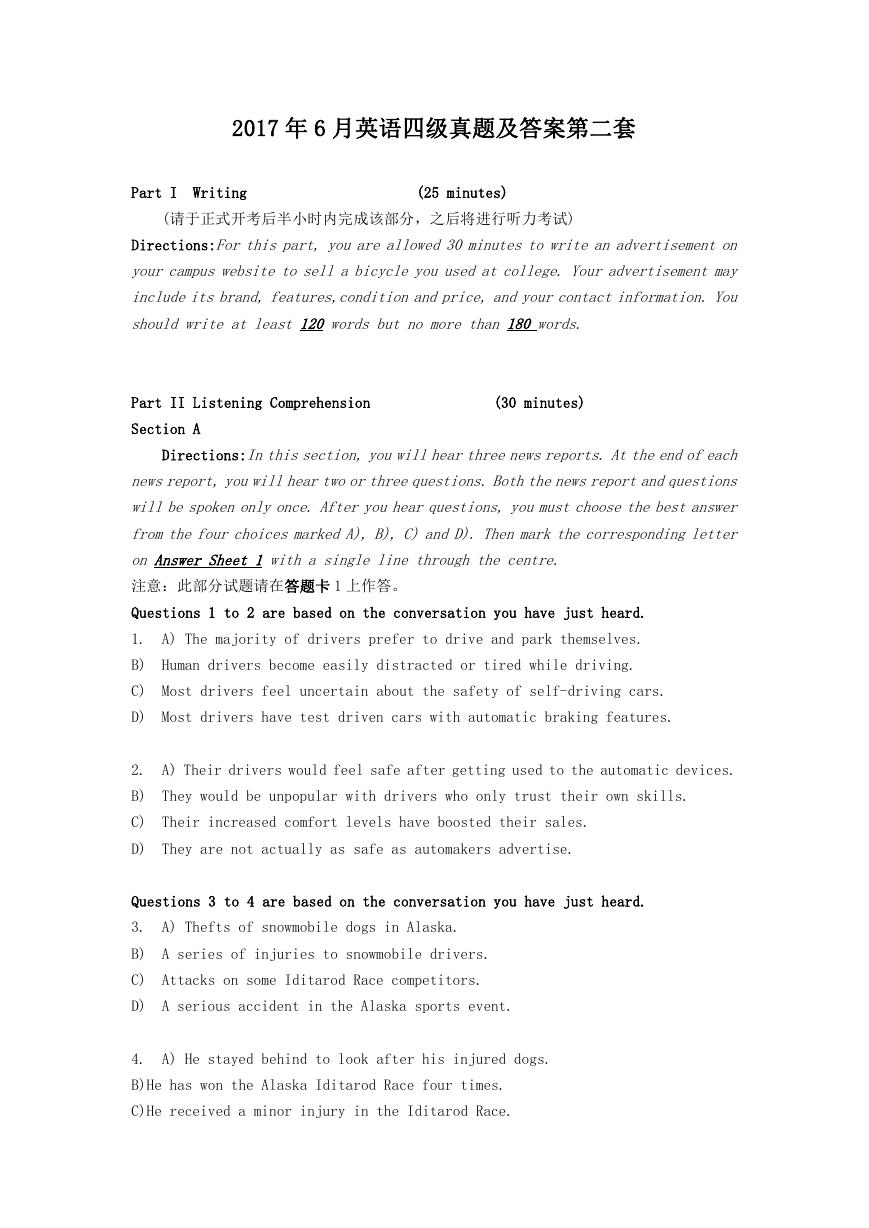
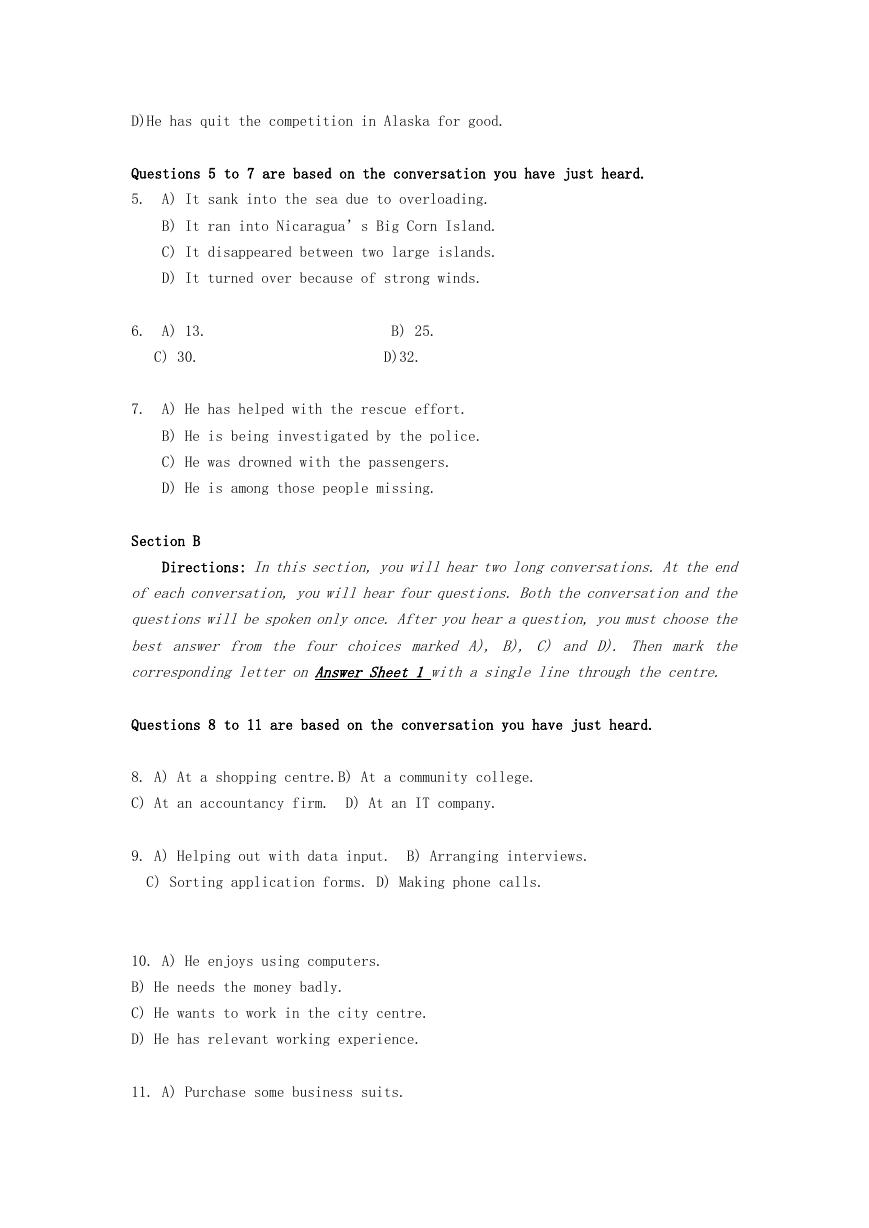
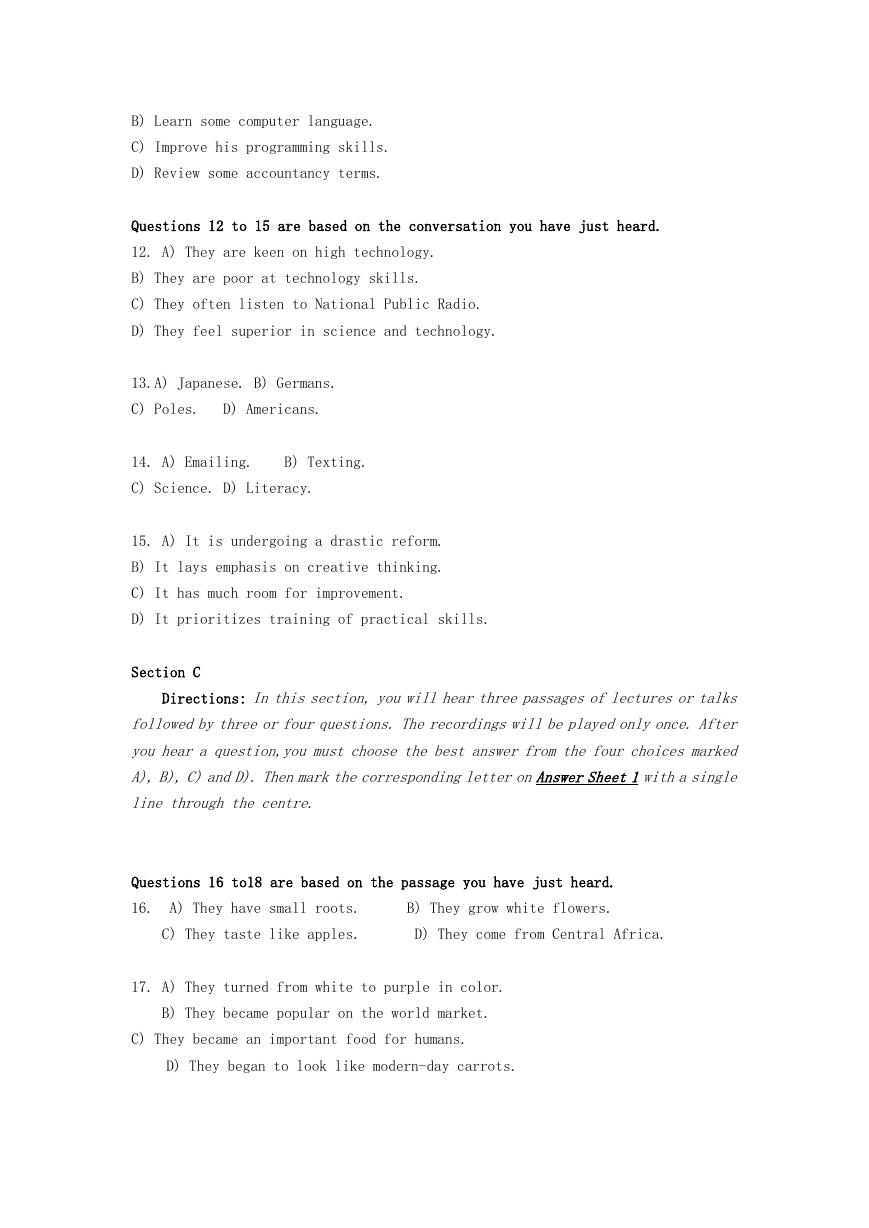
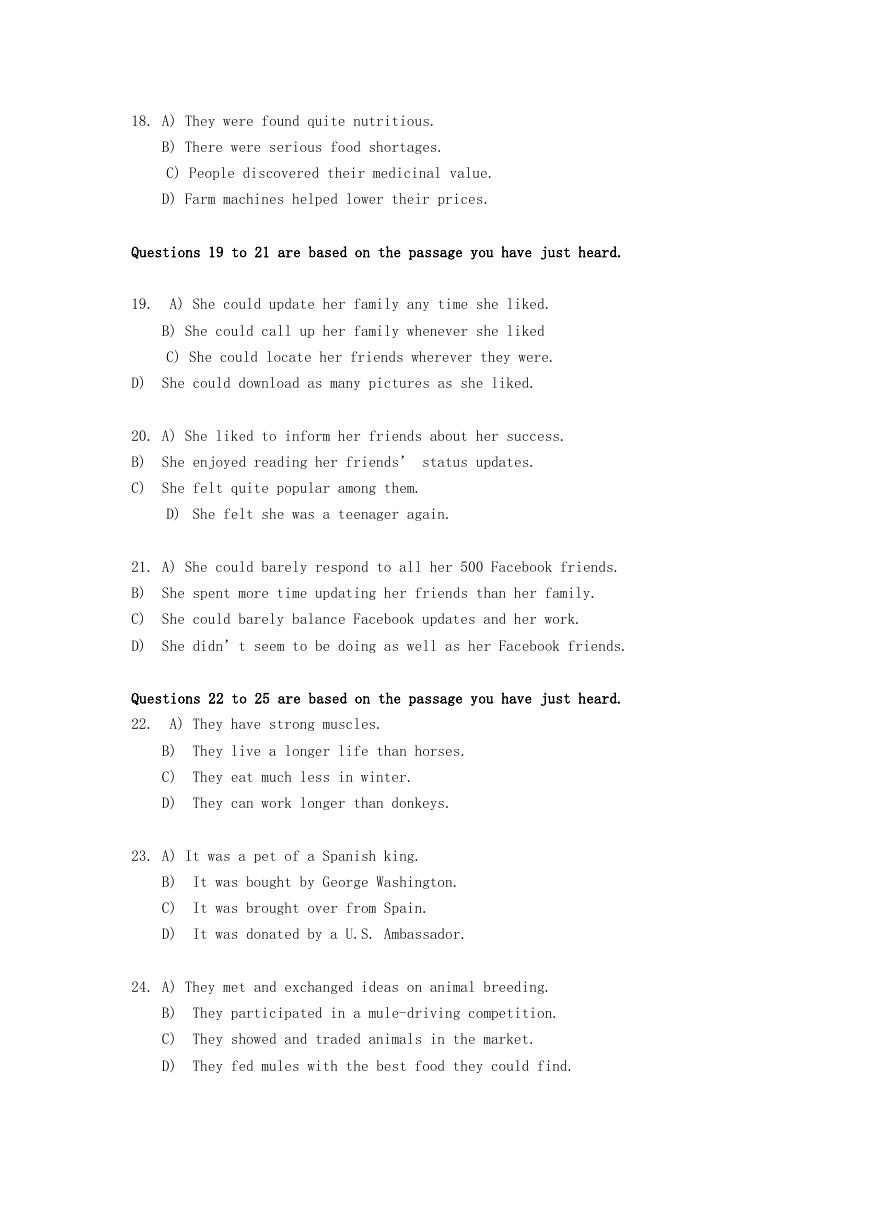
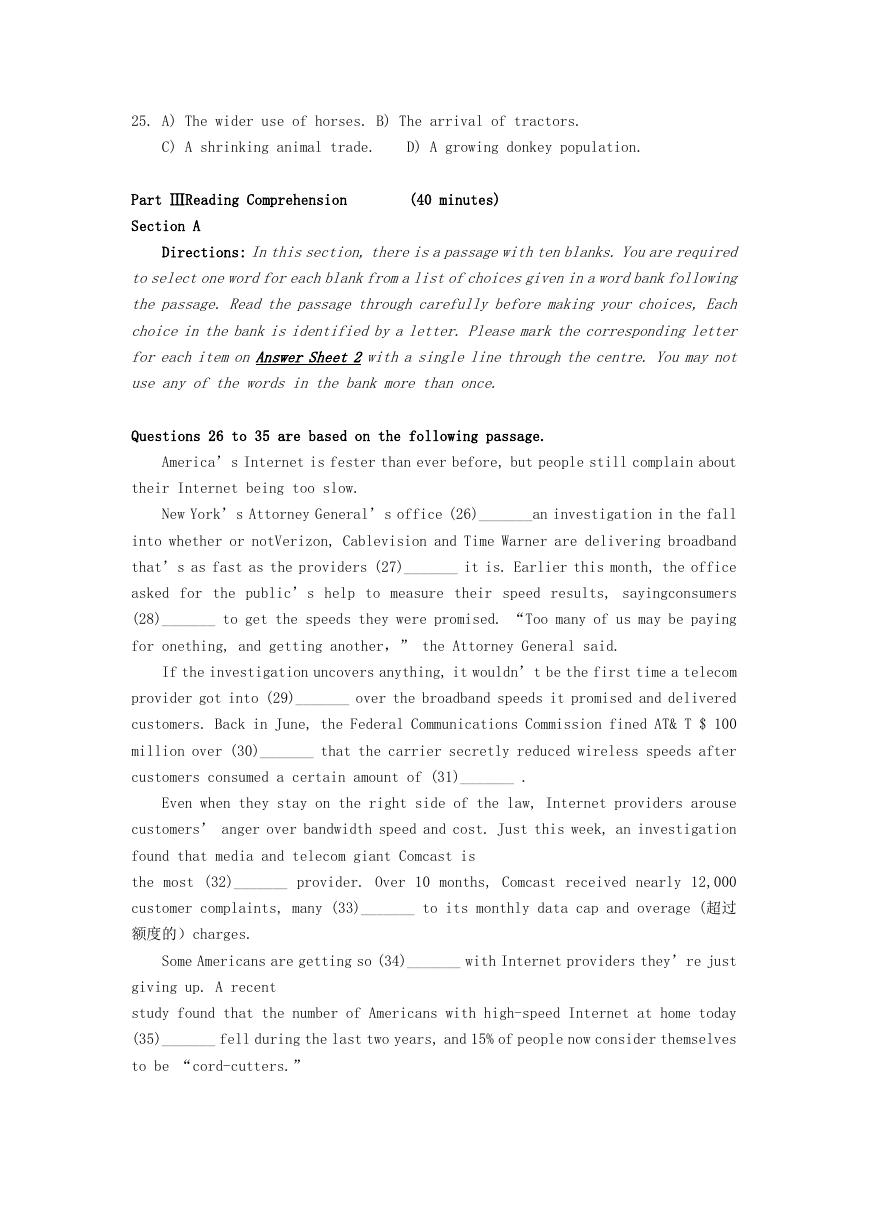

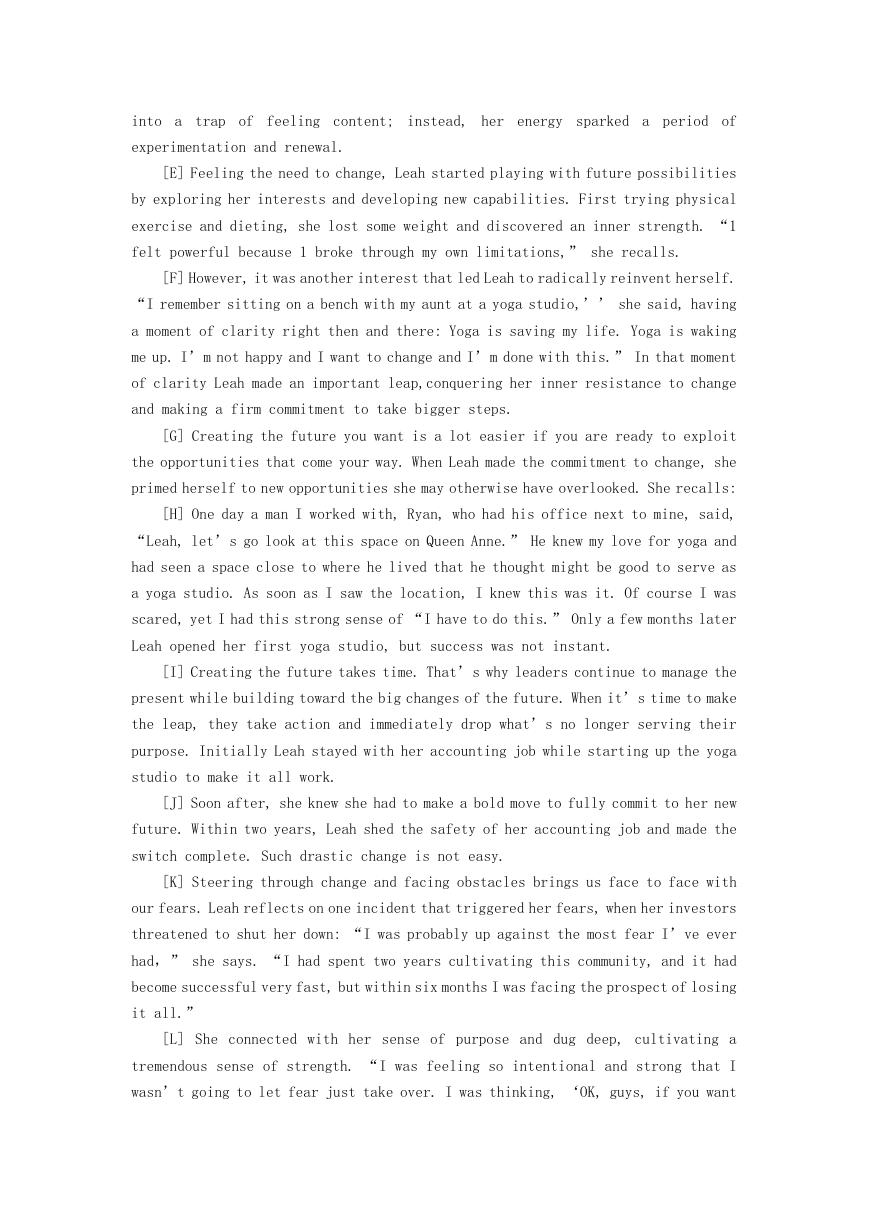









 2023年江西萍乡中考道德与法治真题及答案.doc
2023年江西萍乡中考道德与法治真题及答案.doc 2012年重庆南川中考生物真题及答案.doc
2012年重庆南川中考生物真题及答案.doc 2013年江西师范大学地理学综合及文艺理论基础考研真题.doc
2013年江西师范大学地理学综合及文艺理论基础考研真题.doc 2020年四川甘孜小升初语文真题及答案I卷.doc
2020年四川甘孜小升初语文真题及答案I卷.doc 2020年注册岩土工程师专业基础考试真题及答案.doc
2020年注册岩土工程师专业基础考试真题及答案.doc 2023-2024学年福建省厦门市九年级上学期数学月考试题及答案.doc
2023-2024学年福建省厦门市九年级上学期数学月考试题及答案.doc 2021-2022学年辽宁省沈阳市大东区九年级上学期语文期末试题及答案.doc
2021-2022学年辽宁省沈阳市大东区九年级上学期语文期末试题及答案.doc 2022-2023学年北京东城区初三第一学期物理期末试卷及答案.doc
2022-2023学年北京东城区初三第一学期物理期末试卷及答案.doc 2018上半年江西教师资格初中地理学科知识与教学能力真题及答案.doc
2018上半年江西教师资格初中地理学科知识与教学能力真题及答案.doc 2012年河北国家公务员申论考试真题及答案-省级.doc
2012年河北国家公务员申论考试真题及答案-省级.doc 2020-2021学年江苏省扬州市江都区邵樊片九年级上学期数学第一次质量检测试题及答案.doc
2020-2021学年江苏省扬州市江都区邵樊片九年级上学期数学第一次质量检测试题及答案.doc 2022下半年黑龙江教师资格证中学综合素质真题及答案.doc
2022下半年黑龙江教师资格证中学综合素质真题及答案.doc